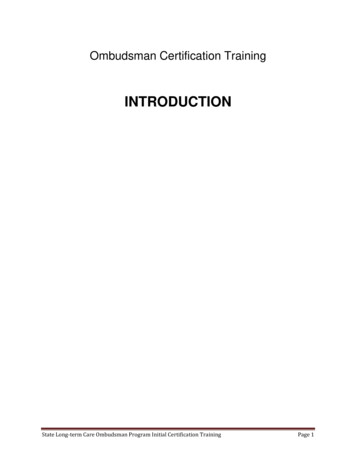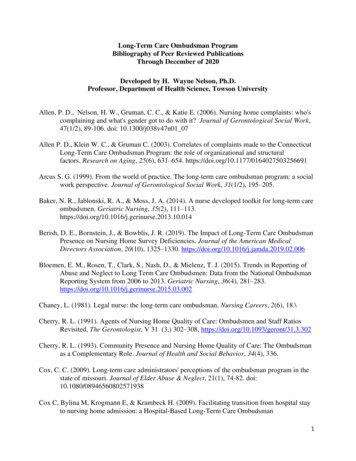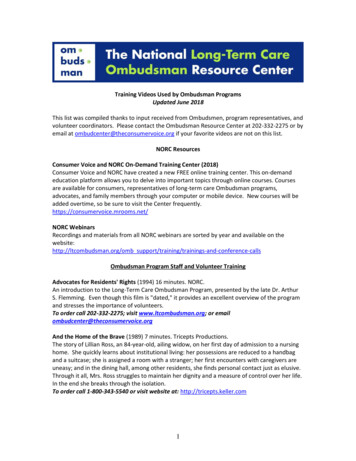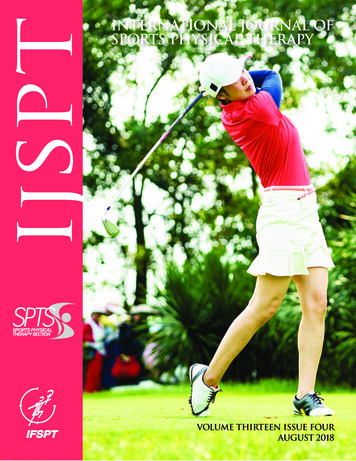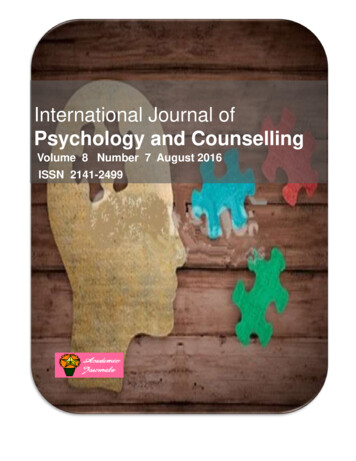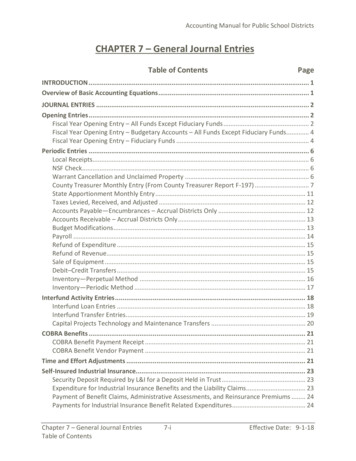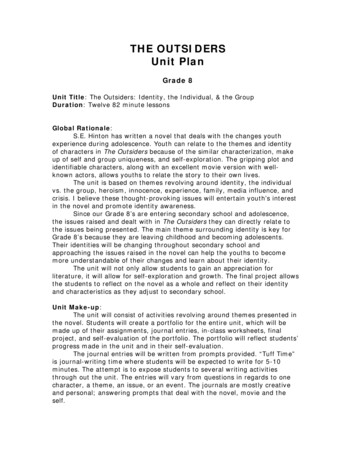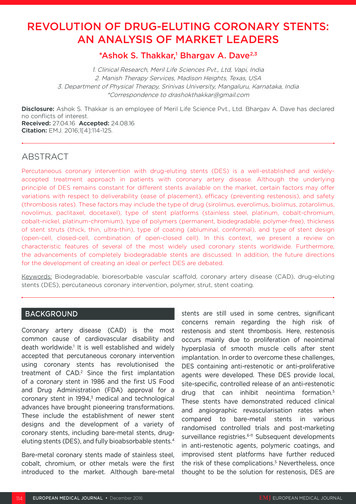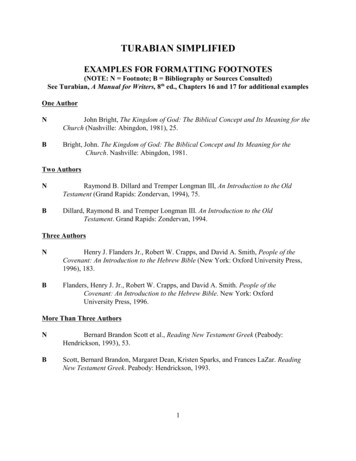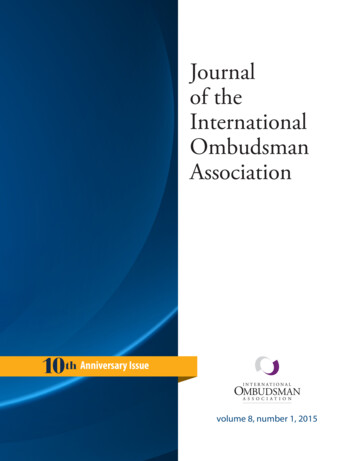
Transcription
Journalof theInternationalOmbudsmanAssociation10th Anniversary Issuevolume 8, number 1, 2015
Journal of the International Ombudsman AssociationTABLE OF CONTENTSvolume 8, number 1, 2015Editorial Staff . . . . . . . . . . . . . . . . . . . . . . . . . . . . . . . . . . . . . . . . . . . . . . . . . . 4Note from the Editors . . . . . . . . . . . . . . . . . . . . . . . . . . . . . . . . . . . . . . . . . . . 5Howard Gadlin and Samantha Levine-FinleyObservations of an “Inside Outsider” on the Future and ChallengesFacing IOA and the Organizational Ombudsman Profession . . . . . . . 8Charles HowardAbstractThis article is an edited and abridged version of a plenary session speech given at the 2014International Ombudsman Association (IOA) Annual Conference by Charles L. Howard. It firstprovides an historical context in which to consider the role an organizational ombudsman and thenpresents a critique of some organizational deficiencies of IOA and observations on the challengesfacing organizational ombuds. Finally, it offers suggestions for addressing these concerns.Keywords: ombudsman, history, dispute resolution, governance, measures of success, public policy,membership, program evaluationMoving Forward with Research in the OrganizationalOmbuds Profession . . . . . . . . . . . . . . . . . . . . . . . . . . . . . . . . . . . . . . . . . . . . . 19Shereen BinghamAbstractThis paper offers a perspective on the place of research in the organizational ombuds profession. Itbegins by examining the disparity that exists between repeated calls for research on organizationalombudsry and the scarcity of published, empirical research in the area. It then considers the historical evolution and obstacles that have deterred our development as an evidence-based profession.Finally, it discusses ideas for moving forward with research in the field and encourages critical reflection as integral to that process.Keywords: ombuds, empirical research, practice paradigm, evidence-based practicevolume 8, number 1, 20151
Journal of the International Ombudsman AssociationBlueprint for Success:Designing a Proactive Organizational Ombudsman Program . . . . . 36John S. BarkatAbstractOrganizational ombudsman programs are increasingly recognized as a best practice of highlyeffective organizations. This article expands John Barkat’s 2002 white paper that has been usedas a guiding and benchmarking document for ombudsmen and the study of integrated disputeresolution systems. It outlines basic features of the organizational ombudsman role, including itskey standards of impartiality, confidentiality, independence, and informality, as well as the threemain functions of problem identification and assistance, organizational critical self-analysis, andpromotion of conflict competence. The article further elaborates on the hallmarks and practicescontributing to the effectiveness of ombudsman programs that not only identify systemic issuesand root causes of problems, but also act as catalysts for change to improve the workplace throughuse of “smart power” and proactive engagement. Integration of these elements into ombudsmanprograms facilitates a proactive and engaged model of practice that can contribute to more efficient,productive, and collaborative organizations.Keywords: ombudsman, organizational change, mediation, conflict competence, soft power, smartpower, systemic issues, root cause, change agent, collaboration, proactive engagementLeveraging Technology in the Ombudsman Field:Current Practice and Future Possibilities . . . . . . . . . . . . . . . . . . . . . . . . . 61Daniel Rainey and Frank FowlieAbstractThis article looks at the possible uses of technology to augment ombudsman practices. Theincreased use of technology in society impacts the way in which clients may wish to communicatewith an ombudsman, and argues that it is incumbent on ombudsman practitioners to stay relevantby the use of technology.Keywords: ombudsman, online dispute resolution, technology, ODR, software, hardwareOnline Dispute Resolution and Ombuds:Bringing Technology to the Table . . . . . . . . . . . . . . . . . . . . . . . . . . . . . . . .73Colin Rule and Indu SenAbstractPeople in industrialized countries now conduct most of their professional and personal communication using technology. Disputes and misunderstandings occur with or without technology, butits proliferation introduces new wrinkles in the fabric of workplace conflicts. Virtual “visitors” to anombudsman’s office and other stakeholders increasingly expect to use technology to help resolveworkplace disputes. In this article, the authors, one a practicing ombuds and the other an onlinedispute practitioner, discuss how technology is changing the work of ombudsmen, offering bothchallenges and opportunities, and share some lessons learned and new capabilities gleaned fromthe field of online dispute resolution (ODR).Keywords: online dispute resolution, ODR, technology, communication, negotiation, virtual, conflictresolution, computer-mediated communication, mediationvolume 8, number 1, 20152
Journal of the International Ombudsman AssociationAuthor Biographies . . . . . . . . . . . . . . . . . . . . . . . . . . . . . . . . . . . . . . . . . . . . . 82Mission Statement . . . . . . . . . . . . . . . . . . . . . . . . . . . . . . . . . . . . . . . . . . . . . 84Principles for Accepting Manuscripts for Publication . . . . . . . . . . . . . 85volume 8, number 1, 20153
Journal of the International Ombudsman AssociationEDITORIAL STAFFEDITOR:Howard GadlinDirector, Office of theOmbudsmanNational Institutes ofHealthBethesda, MDFOUNDINGEDITOR:ASSOCIATEEDITORS:Alan LincolnUniversity Ombuds(retired)University ofMassachusetts LowellLowell, MALawrence CohenAdvisor to theEditorial BoardYale Univ. School ofMedicineNew Haven, CTMary CongerProduction ManagerDoctoral CandidateUniversity of PennsylvaniaPhiladelphia, PASamantha Levine-FinleyDeputy OmbudsmanAmerican Red CrossWashington, DCRobert HarrisInternal OmbudsmanFederal DepositInsurance CorporationWashington, DCDeniz OgretirOmbudsman for theMiddle East, Asia, and thePacificInternational Committeeof the Red CrossREVIEWER PANELCaroline AdamsAssociate Ombuds Universityof California, Santa Barbara,Santa Barbara, CANick DiehlOmbudsmanAsian Development Bank,Manila, PhilippinesShereen BinghamUniversity OmbudspersonUniversity of Nebraska atOmahaFrank FowlieIndependent Mediatorat Organization for theProhibition for ChemicalWeaponsThe Hague, The NetherlandsBrian BlochOmbudsmanOffice of the Special Trusteefor American Indians/ISKCONResolve Cabin John,MDMim GaetanoOmbudsmanMars, Inc.,Ballarat, VIC, AustraliaHelmut BussOmbudsman of theInternational Committee ofthe Red CrossGeneva, SwitzerlandElizabeth GrahamSchool of CommunicationProfessor and Director,The University of Akron,Akron, OHSteven CorderyCorporate OmbudsmanUnited TechnologiesCorporation,Burgess Hill,West Sussex, UKWilbur HicksIOA Distinguished EmeritusMemberBaltimore, MDAngela DashDirector, OmbudsmanNortheast Ohio MedicalUniversity,Rootstown, OHJeffrey DawsonOmbudsmanDuke University,Durham, NCThomas KosakowskiAssociate OmbudsmanUniversity of California,Los AngelesLos Angeles, CAChris LaHatteOmbudsmanICAAN,Wellington, New ZealandAndrew Larratt-SmithUniversity OmbudsmanUniversity of California,RiversideRiverside, CaliforniaThomas SebokDirector, Ombuds OfficeUniversity of Colorado atBoulder,Boulder, COJames LeeConsultant OmbudspersonUN Funds and Programmes,New York, NYJudi SegallOmbudspersonMassachusetts Institute ofTechnologyCambridge, MAAlan LincolnUniversity Ombuds (retired)University of MassachusettsLowell,Lowell, MADave TalbotOmbudsmanThe World Bank GroupMeridian, IDLaurie MesibovUniversity OmbudsUniversity of North Carolina,Chapel Hill, NCShreya TrivediOmbuds OfficerUniversity of Central FloridaOrlando, FLDavid MillerOmbudsmanThe Global Fund to fightAIDS, Tuberculosis andMalariaNew ZealandTom WardStaff OmbudsmanClemson UniversityClemson, SCLaurie Miller-PattersonEmployee OmbudsmanAkron General MedicalCenter,Akron, OHMary RoweOmbudsperson (retired)Massachusetts Institute ofTechnology,Cambridge, MALisa WitzlerAssociate OmbudsmanNIH,Bethesda, MDThomas ZgamboOmbudsmanWorld Bank Group,Washington, DCJohn ZinsserManaging PrincipalPacifica HumanCommunications, LLC,Charleston, SCvolume 7, number 2, 20144
Journal of the International Ombudsman AssociationEDITORIALNote from the EditorsHoward Gadlin and Samantha Levine-FinleyIn many English-speaking countries, tin and aluminum are the traditional gifts for celebrating atenth wedding anniversary because they represent durability and flexibility. Tin is best knownas a component of alloys like bronze (tin and copper) or solder (tin and lead). The InternationalOmbudsman Association (IOA) is itself an alloy, a combination of the University and CollegeOmbudsman Association (UCOA) and The Ombudsman Association (TOA) designed to combinethe strengths of each group of organizational ombuds. And aluminum, the third most commonlyoccurring element in nature, is valued for its ability as a conductor of thermal and electrical energy aswell as its ability to resist corrosion. An apt metaphor for the ombuds role in organizations.This issue of the Journal of the International Ombudsman Association (JIOA) is the first of twoeditions celebrating the ten years of this merger. Appropriately, given the growth of our profession,the focus of most of the articles is on constructing our future rather than celebrating the past. Whichis not to say that we are ignoring that past.Indeed, the first paper, by Charles Howard, originated in a widely acclaimed keynote speech he gaveat the IOA’s 2014 Annual Conference. An attorney who literally wrote the book about the history oforganizational ombuds, Chuck’s thoughts about the future of the IOA begin with an examinationof the broader historical context within which the organizational ombudsman role developed andlocating that role in relation to the growth of large multi-national, multi-cultural organizations, thedecline of unions, and the growing presence of women in the workforce. With these developmentswe face an odd combination of areas of government regulation and legislation mixed with manycomplex dimensions of organizational life for which there are not and cannot be rules, regulationsand formal procedures. This is where Chuck locates our work and he reflects on the challenges facingombuds and IOA as an organization meant to promote, develop and protect organizational ombuds.His observations about the way IOA has to develop further can serve as both cautionary notes and acall to action along many fronts.volume 8, number 1, 20155
Journal of the International Ombudsman AssociationHoward Gadlin andSamantha Levine-FinleyOne of those fronts is research. We are fortunate to have an excellent paper, “Moving Forward withResearch in the Organizational Ombuds Profession,” by Shereen Bingham, who is both a professorof communication and ombudsperson at the University of Nebraska, Omaha. Shereen first reviewsthe somewhat sorry state of current research on the ombuds profession, but then moves us, via acomparison with the social work field, to consider the potential value of bringing an evidence-basedpractice sensibility to our work. Here we get the benefit of Shereen as both a researcher and anombuds because she lays out, in a way that no one in the field has ever done before, four concretesuggestions for moving forward with research: identifying crucial questions, linking those questionsto theoretical frameworks, conducting research in practice settings, and providing support forombuds research.If Shereen has outlined a research program, in his paper, John Barkat, ombudsman for the UnitedNations, provides a vision of the proactively engaged ombudsman that, if it were enacted, couldprovide material to keep teams of researchers busy for decades. In “Blueprint for Success,” anupdated version of a paper John wrote more than ten years ago and that circulated like a samizdat,John calls for a proactive interpretation of the ombudsman role. This is a major reconceptualizationof the ombudsman role. Building on an expansive reading of the four pillars of ombudsman work —confidentiality, independence, neutrality, and informality — John turns them into principles thatcan enable an ombudsman to be a resource for change in his/her organization. John’s blueprintdelineates three major, inter-related ombuds functions: problem assistance, organizational selfanalysis, and the promotion of conflict competence.In keeping with our focus on the future we asked two pairs of authors, independently, to write abouttechnology and its implications and potential for ombuds work. Although there is considerableoverlap in the papers we are publishing both because they address the issues raised for ombuds bytechnology in somewhat different ways and in contrasting, but complementary, voices.Ombuds’ stance toward technology parallels the profession’s reluctance to embrace research; wehave been hesitant about incorporating new technologies and online dispute resolution into ourpractice. Some of that hesitance resides in the belief that nothing can quite match face-to-facecontact as a way of engaging people and establishing trust. This preference for in-person contactflourishes even though many ombudsmen practice in organizations in which there are severelylimited opportunities for such interaction.Another concern is about protecting the confidentiality of online communications. Mostombudsmen decorate the signature bloc of their email with a warning about the difficulty inprotecting the confidentiality of electronic communications. Some even urge people not to useemail for confidential communications or discussing substantive matters. Of course, confidentialityis crucially important, but these papers point out that we live in a time when changes incommunication may be altering the way people think about confidentiality. Both papers begin witha very realistic acknowledgment of the ubiquity of what Dan Rainey, chief of staff for the NationalMediation Board, and Frank Fowlie, ombudsman for the International Organization for Migration atGeneva, refer to as “technology-assisted communication” and direct our thinking to a considerationof its implications for our work.volume 8, number 1, 20156
Journal of the International Ombudsman AssociationHoward Gadlin andSamantha Levine-FinleyOnline dispute resolution pioneer Colin Rule and Indu Sen, ombudsman at the InternationalBaccalaureate Organization, emphasize as well the incredible, and for the most part untapped,potential of online dispute resolution to expand the reach and enhance the impact of ombudsmanprograms everywhere. More important, both papers should lead us to re-think our understandingof confidentiality as well as how to best protect it without taking a Luddite stance towardcontemporary communication technology.On behalf of the Editorial Board, we hope that you find this issue thought-provoking and enjoyable.We welcome your feedback about the JIOA. Please contact us at jioa@ombudsassociation.org toshare ideas and suggestions.volume 8, number 1, 20157
Journal of the International Ombudsman AssociationObservations of an “Inside Outsider” onthe Future and Challenges Facing IOA andthe Organizational Ombudsman ProfessionCHARLES HOWARDABSTRACTACKNOWLEDGMENTSThis article is an edited and abridged versionof a plenary session speech given at the 2014International Ombudsman Association (IOA)Annual Conference by Charles L. Howard. Itfirst provides an historical context in whichto consider the role an organizationalombudsman and then presents a critiqueof some organizational deficiencies of IOAand observations on the challenges facingorganizational ombuds. Finally, it offerssuggestions for addressing these concerns.The author would like to acknowledge theeditorial assistance of Howard Gadlin andSamantha Levine-Finley in preparing thisarticle from the comments delivered by theauthor at the Annual Conference of theInternational Ombudsman Association onApril 9, 2014.KEYWORDSOmbudsman, history, dispute resolution,governance, measures of success, publicpolicy, membership, program evaluationIntroductionI have been described as an “inside outsider” and believe that is a good description. I am not anombudsman, but I have represented ombuds and ombuds offices for twenty-five years, and havebeen intimately involved in many of the legal issues relating to the role. I have enormous respect forwhat ombudsmen do and believe it is an increasingly necessary function in organizations. Despitemy support for the profession—or, rather, because of it—I want to raise various issues in an effort tohelp promote the profession.I will offer some unvarnished observations of the International Ombudsman Association (IOA) frommy perspective as an “inside outsider.” In this sense, my goal is to speak truth to power in the besttraditions of ombuds practice. I will also offer recommendations on how better to proceed. Havingidentified its mission of having an organizational ombuds in every organization, the present challenge for the IOA and ombuds is to identify how they can help the profession move from where it isnow to where they want it to be.volume 8, number 1, 20158
Journal of the International Ombudsman AssociationCharles HowardHistorical ContextTo fully understand this role’s potential for major organizations, one must understand the historicalcontext in which the ombuds profession has developed. By historical context, I am not referringjust to the evolution of the ombuds role from its roots in Scandinavia. That history is familiar toalmost all ombuds (Howard 2010). Rather, I want to focus on the ombuds role in organizations andon my understanding of how society has changed and the pressures that have been placed onorganizations.Let’s begin a hundred years ago, during the Progressive Era in the United States, and consider whatTheodore Roosevelt and the Progressives had to deal with: political corruption brought about by theinfluence of big money, abusive business practices toward workers and labor, and the extraordinaryconcentration of business power and monopolistic practices. There is an analogy today in each ofthese areas. Some of the reforms that came out of the Progressive Era in response to these concernswere the direct election of US senators, a federal income tax, progressive labor reform, and newantitrust laws.In addition, it was during that era that unions began to grow significantly and to serve as acounterbalance to the power of industrial organizations. But the high point of union membership inthe United States was in 1954.1 Union membership has been declining ever since. Currently unionmembership in the private sector is only about 7 percent of the workforce.2 In fact, more than 25percent of all workers are no longer full-time employees; they are part-time, contingent, or contractworkers (Howard 2010, 99–100). This decline in union membership and increase in the percentage ofworkers who are not “full” employees has created an unbalanced relationship between organizationsand workers.It is unlikely that unions in the United States will reemerge as a counterbalancing force againstbusiness or government or large organizations in the immediate future. In addition to the declineof unions, we are now experiencing an unprecedented role for multinational corporations. Basedon data that is now slightly more than ten years old, approximately 80 percent of the world’sindustrial output is produced by the 1,000 largest corporations in the world (Howard 2010, 105).Similarly, of the one hundred largest economies in the world surveyed in 2003, fifty-three werecorporations—another indication of a significant concentration of business power (Howard 2010,82–83). This concentration of economic power would surely be even greater today. In addition, mostof these large corporations are also not only multinational but also multicultural organizations.There are similar trends in academic institutions. In the university context, a significant numberof universities have populations of more than 25,000 students, and American colleges have anunprecedented global focus and numbers of international students (Howard 2010, 82–83, 102–04).These changes present large organizations with challenges that are exacerbated by the increasinguse of technology. There also are other demographic changes, including more gender diversity inthe workforce and in organizational leadership (Howard 2010, 92–93, 95–97).When we look at how our society has responded to these challenges, it has often been through lawand regulation. For example, consider the Dodd-Frank legislation,3 Title VII,4 and the Sarbanes-OxleyAct of 2002.5 But I think, in many ways, law is a clumsy tool to deal with these issues, because it doesnot operate on the front line. Let’s take three examples.volume 8, number 1, 20159
Journal of the International Ombudsman AssociationCharles HowardFirst, in order to protect people from retaliation, the law has tended to create a cause of action forretaliation. Unfortunately, the law cannot really protect people from retaliation. It only gives a persona cause of action to bring a retaliation claim. If a person has been retaliated against, he or she has theright to bring a lawsuit to claim that they suffered retaliation because, for example, that person was awhistle-blower. But at this point, that person has already lost, because in our system of law, he or shehas become the adversary and the whole force of the organization is pitted against him or her.Second, there are many whistle-blower laws in the United States offering bounties to a whistle-blower who prevails on his or her claim, but these laws are not responsive to the dilemma faced by realpeople when they are considering whether to become whistle-blowers. A person has to decide thathe or she is going be a whistle-blower without clear assurance that the claim will succeed or that thegovernment will make a recovery on which a bounty will be paid. Even if the government ultimatelydetermines that the whistle-blower is entitled to a bounty, the whistle-blower won’t receive thatbounty until several years down the road (Howard 2010, 147–57; Kesselheim et al. 2010). And whathappens to these people in the meantime? It is often a very difficult time for them—personally, professionally, and financially—and most will never receive a bounty (Howard 2010).Third, although there is a plethora of governmental legislation and regulation in an attempt toprotect whistle-blowers from retaliation, so much of what whistle-blowers experience—and whatorganizational ombuds must deal with in the workplace or other areas where they operate—is whatI would call interactions that can be retaliatory but are “below the radar.” It is in this space that lawsand regulations are particularly ineffective, and it is this space where we most need a solution tohelp people and organizations. There is a limit to how effective laws and regulation can be in addressing “below the radar” retaliation, which can be quite chilling to experience.So who is going be on the front line to deal with these issues? Who is going to deliver value to largeorganizations and the people in them, to provide assistance in the face of how the organizationshave evolved globally, the economic pressure on them, and the limitations of laws and regulations?It does not suffice to say this is a role that unions previously played—a role that has expanded withthe growth and complexity of society—but unions cannot fill the role today. I believe organizationalombudsmen are ideally suited to fill that role.ROLE OF THE ORGANIZATIONAL OMBUDSMANIn contemplating the function that can be served by filling this role, my goal is to challenge readersto think in larger terms. In particular, I urge readers to consider two other points that I think shouldbe the essential characteristics of whatever mechanism is designed to fit in that space.The first is the concept of checks and balances, which was one of the most fundamental principlesin the design of the US government. In our private entities, businesses, foundations, universities, orany other type of organization that has a linear, top-down decision making model, however, a similarconcept of checks and balances is rare. These organizations operate based on a pyramidal structure,with management decisions made at the top. Yet, when an organization has 10,000 or 20,000 or100,000-plus employees and workers, inevitably there will be organizational blockages, conflict, andmisconduct.volume 8, number 1, 201510
Journal of the International Ombudsman AssociationCharles HowardThere is no question of whether an organization’s systems will fail on occasion; it is only a questionof when and where. And the key systems design question is: How does one surface issues that areblocked? How do we remove those blockages? That is where I think ombuds come in. We can’t havedual drivers of the enterprise, but we can have an information flow to the top outside of the standardchannels—and a mechanism to help an organization know where blockages are and how to dealwith issues that have gotten stuck, thereby preventing them from surfacing.My second observation is that there are many formal reporting structures as a result of pressuresfrom the law, as well as legislative and regulatory requirements. Indeed, I think there are so manylaws and regulations from so many levels of government and other sources that the average person,including a reasonably experienced lawyer like me, often does not know where to go to raise anissue or how to address a concern. In a multicultural/multinational world, we should be asking ourselves what the sources of organizational information are—and how someone accesses informationwithout triggering all of the investigational machinery that might then be used against him or her. Aconfidential source of information is therefore crucial.In trying to answer these questions, my analysis suggests that modern large organizations need amechanism that can help to provide checks and balances by serving as an informal and confidentialsource of information and advice on options for surfacing issues and concerns. In my opinion, thatis where the organizational ombudsman comes in. I believe this is an important role and that, asa result, every major organization should have an organizational ombuds. Although this will be achallenging undertaking to make a reality, I believe that seeing the development of the role forombuds in this historical context should inspire us all.Current Challenges Facing IOASMALL SIZEMy first observation is that IOA is too small. The organization has grown gradually and now hasalmost 800 members. The IOA puts on a great conference, but if the goal is ombuds ubiquity, thispace and approach will not get the profession where it wants to be quickly enough. In a 2011 surveyof Fortune 1000 companies, following up on a 1997 survey, only 14 percent of those companies hadombuds (Stipanowich and Lamare 2014). That 14 percent included anything that called itself anombuds program, whether or not it operated in accordance with the IOA Standards of Practice. Thatnumber also represents a 40 percent increase in the utilization of ombuds programs over 1997, whenthe corresponding number was 10 percent (Stipanowich and Lamare 2014). Nevertheless, even a 14percent penetration level is not enough to serve as a launching point for where the profession wantsto go. Although there is more widespread acceptance of the ombuds concept today in colleges anduniversities, the role is far from universal even in that setting.The small size of IOA means the organization does not have the money to accomplish its goals. Forthis reason, I would challenge IOA to think big: have a vision of where it can be and a belief that itcan do something, even though the way is unclear. If IOA really does believe that an ombuds program is a function that should be in every major organization, IOA will need to become much biggerthan it is today.OVERRELIANCE ON VOLUNTEERSI believe that IOA is too dependent on its members for volunteer help in almost every aspect of whatit does. One could not find a more dedicated and capable group of people. For example, those whovolume 8, number 1, 201511
Journal of the International Ombudsman AssociationCharles Howardhave served as president of IOA have done so on essentially a full-time basis despite the fact thateach one also had a very demanding day job. However, I have observed burnout in these leadersafter a year or two in this dual role. I believe this burnout is unnecessary, because there should be away to enable volunteers to serve as leaders without having it take all of their time. To do that, however, requires both staff and IOA volunteers to assist with follow-through on policy decisions, as wellas retaining people with specialized knowledge or skills, such as lawyers or management consultants, so that not everything has to be accomplished solely through the use of volunteers. To moveto the next level, where IOA can achieve its mission, IOA will require staff and specialized assistancefrom outside its member base. I applaud IOA’s current efforts to move in this direction, but this takesmoney, which reinforces my first point: IOA needs to have a larger footprint and thus a bigger revenue base to accomplish its mission.LEADERSHIP TURNOVERA related concern is turnover on the IOA’s board of directors. This suggests that there is not enoughcontinuity for long-term policy decisions. IOA is experiencing
provide material to keep teams of researchers busy for decades. In “Blueprint for Success,” an updated version of a paper John wrote more than ten years ago and that circulated like a samizdat, John calls for a proactive interpretation of the ombudsman role. T
